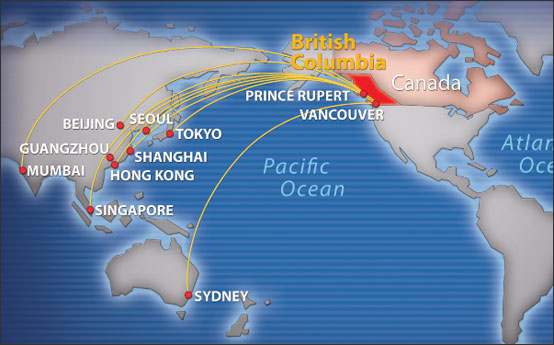Canada’s Pacific Gateway
What we want to accomplish
- Competitive infrastructure to open Canada’s Pacific Gateway.
- A Pacific Coast collaborative to work with West Coast states on a range of common economic and environmental issues.
A new world order is upon us. It will be dominated by trade with China, Taiwan, Hong Kong, Japan, India and South Korea. China’s
economy has doubled in the last 10 years, and it has driven 30 per cent of the world’s growth in GDP in the last decade. China
is now Canada’s second-largest trading partner.
British Columbia is Canada’s gateway to the Pacific and, with ports closer to China than those in the mainland U.S., British
Columbia can become a North American centre for Asia-Pacific trade.
By 2020, container traffic with Asia is expected to increase by 300 per cent, and air passenger traffic is expected to double. Shipping from Asia to Prince Rupert saves 1,000 nautical miles of travel compared to shipping to Los Angeles.2
Moreover, British Columbia’s large Chinese and Indian communities create strong cultural ties to potential trading partners
in Asia. This advantage, coupled with an open trading economy, a strong multicultural society and our reputation as a renowned
tourism destination mean that B.C. is well positioned to build on our Asia-Pacific connections as the Asia-Pacific continues
to modernize and grow.
But the world won’t wait for us. Every country in the world is competing against us for a larger piece of the Asian economic
opportunity. We need to establish our Pacific leadership agenda. We need to expand Gateway infrastructure and build stronger
relationships with Asia-Pacific nations through such initiatives as inter-modal transportation links, cultural exchange opportunities,
and educational partnerships and — with the federal government — immigration and international commerce links.
British Columbia will develop its infrastructure for B.C. and for the West to provide the same types of opportunities that
the St. Lawrence Seaway did for Ontario and eastern Canada 50 years ago. Government will push for a unified Pacific Port Authority
to ensure co-ordinated trade through all B.C. ports. We will work with the Northwest to establish an integrated port plan for
the millions of container shipments that will come from increased trade. We will also work to establish an inland port at
Prince George to move air, sea, and land cargo through to Asian and North American markets in record time.
As we open our northern and interior ports, British Columbia will use Public Private Partnerships or "P3s" to build the new
South Fraser perimeter truck bypass highway. Other important infrastructure projects like the Pitt River Bridge and the Port
Mann Bridge will get resources to markets. The Kicking Horse Canyon project will open up Canada’s gateway to the Pacific.
Investments in airports, roads and bridges and critical improvements along Highway 97 and the Trans-Canada highway will create
further links to markets and people beyond British Columbia’s borders.
British Columbia will launch a new Pacific Coast collaborative with Alaska, Washington, Oregon, and California. Directly to
the south of our province is the U.S. coastal region, with close to 50 million people. California alone has 36 million people
and a GDP 50 per cent larger than Canada’s. The collaborative will provide an opportunity to work together on a range of issues,
including climate change, ocean health and the environment, clean energy, transportation infrastructure, cross-border investment
in emerging technology clusters, and initiatives in wellness and active living.

|
| 2 |
Based on shipping from Hong Kong to Prince Rupert. |
Actions such as these will allow us to achieve our great goal to:
- Create more jobs per capita than anywhere else in Canada